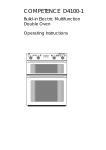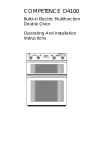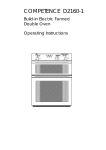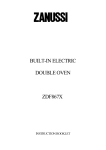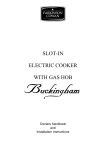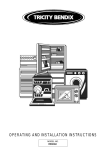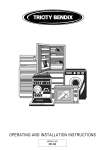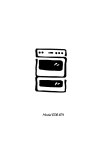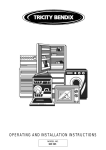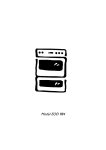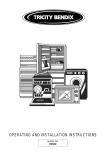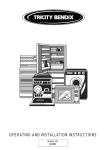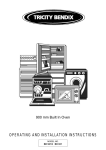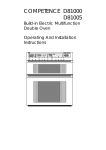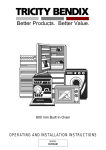Download Electrolux D2160 User's Manual
Transcript
COMPETENCE D2160 Build-in Electric Fanned Double Oven Operating And Installation Instructions IMPORTANT SAFETY INFORMATION These warnings are provided in the interests of your safety. Ensure that you understand them all before installing or using the cooker. Your safety is of paramount importance. If you are unsure about any of the information in this book contact the Customer Care Department. Telephone 0870 5 350350 Stand clear when opening the drop down oven doors. Support the doors using the handles until fully open. Never leave the cooker unattended when the oven door is open. Do not place sealed cans or aerosols inside the oven. They may explode if they are heated. Ensure that all control knobs are in the OFF position when not in use. Do not stand on the cooker or on the open oven doors. Do not hang towels, dishcloths or clothes from the cooker or its handles. They are a safety hazard. INSTALLATION The cooker must be installed according to the instructions supplied. The cooker must be installed in an adequately ventilated room. NOTE: It is imperative that the appliance is left in the base to protect both the appliance and the floor. This cooker is heavy and care must be taken when moving it. Do not try to move the cooker by pulling the door handles. Warning: Do Not attempt to lift this appliance by the handles. All packaging, both inside and outside the cooker must be removed before the cooker is used. It is dangerous to alter the specifications or modify the cooker in any way. After installation please dispose of the packaging with due regard for safety and the environment. Your local authority can arrange this. CLEANING AND MAINTENANCE The cooker is heavy and care must be taken when moving it. For Hygiene and safety reasons this cooker should be kept clean at all times. A build-up of fats or other foodstuffs could result in a fire especially in the grill pan. This cooker should be kept clean at all times. A build-up of fats or other foodstuffs could result in a fire, especially in the grill pan. Do not leave cookware containing foodstuffs, e.g. fat or oil in the cooker in case it is inadvertently switched on. Always allow the cooling fan to cool the cooker down before switching off at the wall prior to carrying out any cleaning / maintenance work. Only clean this cooker in accordance with the instructions given in this book. CHILD SAFETY Do not allow young children to play with any part of the packaging. This cooker is designed to be operated by adults. Young children must not be allowed to tamper with the controls or play near or with the cooker. The cooker and accessible parts especially around the grill area become hot when the cooker is in use. Keep children away until it has cooled. DURING USE SERVICE This cooker has been designed for domestic use to cook edible foodstuffs only, and must not be used for any other purpose. Take great care when heating fats and oils as they will ignite if they become too hot. Never place plastic or any other material which may melt in or on the oven. Do not stand too close to the oven or grill while in use as warm air will exhaust from the grill cavity and the vents on the front frame of the cooker. Always use oven gloves to remove and place food in the oven. Ensure that all vents are left unobstructed to ensure ventilation of the oven cavity. Never line any part of the cooker with aluminium foil. Repairs should not be carried out by inexperienced persons as this may cause injury or serious malfunction. This cooker should be serviced by an authorised Service Engineer and only genuine approved spare parts should be used. Details of servicing and repair arrangements are supplied on page 35 of this book. AT THE END OF THE COOKERS LIFE When the time comes to dispose of your cooker please contact your local Council Authority. They can arrange to dispose of the cooker in a safe and controlled manner. The number will be in the telephone book. Please read this instruction book carefully before use and retain for future reference. 1 CONTENTS FOR THE USER FOR THE INSTALLER Important Safety Information . . . . . . . . . . . . . . . . 1 Description Of The Oven . . . . . . . . . . . . . . . . . . . . Getting To Know Your Oven . . . . . . . . . . . . . . . . . . . The Cooling Fan For The Controls . . . . . . . . . . . . . Control Panel Indicator Neons . . . . . . . . . . . . . . . . . Grill And Oven Furniture . . . . . . . . . . . . . . . . . . . . . . . Before Using For The First Time . . . . . . . . . . . . . . . When First Switching On . . . . . . . . . . . . . . . . . . . . . . Rating Plate . . . . . . . . . . . . . . . . . . . . . . . . . . . . . . . . . . . Condensation And Steam . . . . . . . . . . . . . . . . . . . . . Cookware . . . . . . . . . . . . . . . . . . . . . . . . . . . . . . . . . . . . Technical Details . . . . . . . . . . . . . . . . . . . . . . . . . . . 32 Warnings . . . . . . . . . . . . . . . . . . . . . . . . . . . . . . . . . . . . . 33 3 4 4 4 5 6 6 6 6 6 The Electronic Timer . . . . . . . . . . . . . . . . . . . . . . . . . 7 The Dual Grill . . . . . . . . . . . . . . . . . . . . . . . . . . . . . . . Using The Grill . . . . . . . . . . . . . . . . . . . . . . . . . . . . . . . Things To Note . . . . . . . . . . . . . . . . . . . . . . . . . . . . . . The Grill Pan And Handle . . . . . . . . . . . . . . . . . . . . . Hints And Tips . . . . . . . . . . . . . . . . . . . . . . . . . . . . . . . Grilling Chart . . . . . . . . . . . . . . . . . . . . . . . . . . . . . . . . . 11 11 11 12 12 13 The Second Oven . . . . . . . . . . . . . . . . . . . . . . . . . . . Using The Second Oven . . . . . . . . . . . . . . . . . . . . . Things To Note . . . . . . . . . . . . . . . . . . . . . . . . . . . . . . To Fit The Second Oven Shelf . . . . . . . . . . . . . . . . Hints And Tips . . . . . . . . . . . . . . . . . . . . . . . . . . . . . . . 14 14 14 14 15 The Main Fan Oven . . . . . . . . . . . . . . . . . . . . . . . . . Using The Fan Oven . . . . . . . . . . . . . . . . . . . . . . . . . Things To Note . . . . . . . . . . . . . . . . . . . . . . . . . . . . . . To Fit The Main Oven Shelves . . . . . . . . . . . . . . . . Hints And Tips . . . . . . . . . . . . . . . . . . . . . . . . . . . . . . . 16 16 16 16 17 20 20 20 20 Care And Cleaning . . . . . . . . . . . . . . . . . . . . . . . . . . Cleaning Materials . . . . . . . . . . . . . . . . . . . . . . . . . . . Cleaning The Outside Of The Oven . . . . . . . . . . . Cleaning Inside The Ovens . . . . . . . . . . . . . . . . . . . Cleaning The Door Glass . . . . . . . . . . . . . . . . . . . . . Cleaning The Grill And Oven Furniture . . . . . . . . Replacing An Oven Light Bulb . . . . . . . . . . . . . . . . 23 23 23 23 24 25 25 If Something Doesn't Work . . . . . . . . . . . . . . . . . Guarantee Conditions . . . . . . . . . . . . . . . . . . . . . . Service and Spare Parts . . . . . . . . . . . . . . . . . . . . Service Force Centres . . . . . . . . . . . . . . . . . . . . . . 26 28 29 30 33 34 34 35 36 36 Making The Electrical Connections . . . . . . . . . Preparing Cable . . . . . . . . . . . . . . . . . . . . . . . . . . . . . . To Remove Cover Of Mains Terminal . . . . . . . . . Connecting To The Mains Terminal . . . . . . . . . . . Connecting To A Hob Or Cooker Point . . . . . . . . Checking Electrical Connections . . . . . . . . . . . . . . 36 36 37 38 38 38 Fitting Into The Cabinet . . . . . . . . . . . . . . . . . . . . . 39 Oven Cooking Chart . . . . . . . . . . . . . . . . . . . . . . . . 18 Roasting Chart . . . . . . . . . . . . . . . . . . . . . . . . . . . . . . 19 Defrosting . . . . . . . . . . . . . . . . . . . . . . . . . . . . . . . . . . Using Defrost Feature . . . . . . . . . . . . . . . . . . . . . . . . Things To Note . . . . . . . . . . . . . . . . . . . . . . . . . . . . . . Hints And Tips . . . . . . . . . . . . . . . . . . . . . . . . . . . . . . . Helpful Hints When Buying And Preparing Food ..................................... Choice Of Electrical Connection . . . . . . . . . . . . Things To Note . . . . . . . . . . . . . . . . . . . . . . . . . . . . . . Preparing Cabinet For Fitting Oven . . . . . . . . . . . Recommended Cabinet Dimensions . . . . . . . . . . How To Finish Unpacking . . . . . . . . . . . . . . . . . . . . Tools Required . . . . . . . . . . . . . . . . . . . . . . . . . . . . . . . 22 2 DESCRIPTION OF THE OVEN Build-in electric fanned double oven. Electronic Timer Control Panel Top Oven Main Oven Please note that the handle type on your product may differ in type and shape from that shown in the diagram. Your build-in oven comprises of a conventional second oven and dual grill in the top compartment. The main fanned oven is the larger of the two ovens. It can be automatically controlled by the electronic timer. To help you the following symbols will be found in the text. Safety Instructions 1, 2, 3, Step by Step Instructions Hints and Tips 3 GETTING TO KNOW YOUR OVEN The Control Panel A - Main Oven Temperature Control B - Main Oven Indicator Neon C - Electronic Timer D - Dual Grill Control E - Grill Indicator Neon F - Second Oven Indicator Neon G - Second Oven Temperature Control The Cooling Fan for the Controls The cooling fan comes on immediately when the grill is switched on and after a short time when either of the ovens are in use. It may run on after the controls are switched off until the appliance has cooled. During the initial period the cooling fan may turn ON and OFF, this is quite normal. Control Panel Indicator Neons These lights indicate whether the grill or ovens are switched ON. In the case of the ovens, the neons also indicate when the set temperature has been reached. The indicator neon will go out when the oven has reached the set temperature. It will turn on and off during cooking to show that the oven temperature is being maintained. If the neons do not operate as the instructions indicate the controls have been incorrectly set. Return all controls to zero and reset following the instructions for the required setting. 4 2 straight shelves (for main oven cooking) GRILL AND OVEN FURNITURE The following items of grill and oven furniture have been supplied with the cooker. If you require replacements of any of the items listed below, please contact your local Service Force Centre quoting the relevant part number. The grill deflector sits above the grill element and prevents fat splashing onto the grill roof. 1 grill pan The deflector may be easily removed for cleaning. (311409401) 1 grill pan handle (311468100) Note If you require an additional handle for your grill pan, this can be ordered from your local AEG Service Centre by quoting part number 311479800\6 1 grill pan grid (311419801) 1 grill deflector 1 meat tin (311409401) 1 trivet (311419701 1 cranked shelf (for grilling and second oven cooking only) 5 BEFORE USING THE OVEN FOR THE FIRST TIME When first switching on When the cooker is first switched on at the wall the timer will flash. Press buttons ( and ) together, while holding them down press (+) button until the correct time of day is reached. To use the timer refer to instructions on page 7. Rating plate Record the model, product and serial numbers on the inside back cover of this instruction book from the rating plate. This is situated on the lower front frame of the oven and can be seen upon opening the main oven door. The oven must be protected by a suitably rated fuse or circuit breaker. The rating of the oven is given on the rating plate. The rating plate must not be removed from the oven front frame as this may invalidate the guarantee. Preparing to use your oven Clean the ovens with a soft cloth and hot soapy water and wash the grill and oven furniture before use. The grill and ovens should be heated without food to burn off any residue from the elements. To do this, run the ovens at 220°C for 10 - 15 minutes. The procedure should be repeated with the grill for approximately 5 - 10 minutes. During this period an odour may be emitted, it is therefore advisable to open a window for ventilation. Condensation and Steam When food is heated it produces steam in the same way as a boiling kettle does. The ovens are vented to allow some of this steam to escape. However, always stand back from the cooker when opening the oven doors to allow any build up of steam or heat to be released. If the steam comes into contact with a cool surface on the outside of the cooker, e.g. a trim, it will condense and produce water droplets. This is quite normal and is not caused by a fault on the cooker. To prevent discolouration occurring, regularly wipe away condensation and any soilage from the cooker surfaces. Cookware Baking trays, oven dishes etc., should not be placed directly against the grid covering the fan at the back of the oven. Do not use baking trays larger than 30cm x 35cm (12" x 14") as they will restrict the circulation of heat and may affect performance. Do not place bakeware directly on the second oven base when the oven is on as damage to the oven enamel and bakeware will occur. 6 A ELECTRONIC TIMER B C KEY A AUTO DISPLAY B COOKPOT SYMBOL C BELL SYMBOL D MINUTE MINDER BUTTON E COOKING HOURS BUTTON F STOP TIME BUTTON G MANUAL SELECTOR BUTTON H DECREASE CONTROL I INCREASE CONTROL D NOTE: The time of day must be set before the main oven will operate manually. 1. SET THE TIME OF DAY When the electricity supply is first switched ON, the display will flash both 0.00 and AUTO as Fig. 1. Press the two buttons marked ( ) and ( ) while holding them down, press the increase control button (+) and if necessary, the decrease control button (-) until the correct time on the 24 hour clock is reached, e.g. 10.00am as Fig. 2. The AUTO symbol will go out. Note: The increase and decrease control buttons operate slowly at first, and then more rapidly. They should be pressed separately. Fig. 1 Fig. 2 2. THE MINUTE MINDER The minute minder gives an audible reminder at the end of any period of cooking up to 23 hrs 59 mins. It is not part of the automatic control. To set, press the minute minder button ( ) and the display will read 0 . 00 as Fig.3. While holding it down, depress the increase control (+) until the display indicates the interval to be timed, e.g. 1hr 45 mins as Fig. 4. If necessary depress the decrease control (-) to achieve the correct time interval. NOTE: This must be completed within 5 seconds of first pressing the minute minder button. Release the minute minder button and the display will return to the time of day after 5 seconds. During the operation of the minute minder, the remaining time period can be shown in the display Fig. 3 Fig. 4 7 E F G H I by pressing the minute minder button ( ) as Fig. 5. The minute minder will sound intermittently for up to 7 minutes at the end of the timed period. The sound can be stopped by pressing the ( ) button. TO CANCEL THE MINUTE MINDER If you change your mind and want to cancel the minute minder, press the minute minder button ( ) and then the decrease control ( - ) until 0 . 00 shows in the display and the alarm sounds. To stop the sound, press ( ) button. The time of day shows in the display after a few seconds. Fig. 5 3. SETTING THE OVEN TIMER CONTROL The main oven only can be automatically timed. When using the timer control for the very first time, it is advisable to let it operate while you are at home. The displays can be checked to show that it is operating correctly and you will feel confident to leave a meal to cook automatically in the future. A) TO SET THE TIMER TO SWITCH ON AND OFF AUTOMATICALLY i) Ensure the electricity supply is switched ON and that the correct time of day is displayed, e.g. 9.a.m. as Fig. 6. ii) Place food in oven. iii) To set the length of cooking time, press the cooking hours button ( ) while holding it down, press the increase control ( + ) until the required length of cooking time is displayed, e.g. 2 hrs 15 mins as Fig. 7. If necessary depress the decrease control ( - ) until the correct time interval is achieved. iv) Release the buttons. The AUTO display will glow. Remember, this must be completed within 5 seconds of first pressing the cooking hours button. v) Set the STOP time. Press the stop time button ( ), while holding it down, press the increase control ( + ) until the required stop time is displayed, e.g. 12.15p.m. as Fig. 8. If necessary depress the decrease control ( - ) until the correct time interval is achieved. vi) Release the buttons. The time of day will be displayed after 5 seconds. vii) Set the main oven control to the required temperature. The oven indicator neon should be OFF and the AUTO display will glow. Note: When the automatic timed period starts, the oven indicator neon will turn ON and OFF during cooking. The cookpot symbol will show in the display. Fig. 6 Fig. 7 Fig. 8 8 B) TO SET THE TIMER TO SWITCH OFF ONLY i) Ensure the electricity supply is switched ON and that the correct time of day is displayed, e.g. 10.00am as Fig. 9. ii) Place food in oven. iii) To set the length of cooking time, press the cooking hours button ( ), while holding it down, depress the increase control ( + ) until the required length of cooking time is displayed, e.g. 2 hrs 15 mins as Fig. 10. Depress the decrease control (-) if necessary. Fig. 9 iv) Release the buttons. The AUTO display will glow and the time of day will be displayed after 5 seconds. v) Set the oven temperature. The oven indicator neon should be ON. Fig. 10 vi) To check the stop time during the cooking period, simply press the stop time button ( ) and the stop time will be displayed, as Fig. 11. Fig. 11 4. TO CANCEL PROGRAMME i) AN AUTOMATIC To cancel an automatic programme, press ( ) button. The AUTO display will go out and the cookpot symbol will light, as Fig.12. ii) Turn off oven control. 5. TO RETURN MANUAL THE Fig. 12 COOKER TO At the end of a timed cooking period, the AUTO display will flash and an alarm will sound for up to 7 minutes. i) To stop the sound press any of the first three buttons, as Fig. 13. ii) Turn off oven control. AUTO display will continue to flash. iii) Press ( ) button. See Fig. 14. The AUTO display goes out and the cookpot symbol will show. iv) Turn the oven control on to check the oven operates normally. The oven indicator neon will glow. v) Turn off the oven control. Fig. 13 Fig. 14 9 6. THINGS TO NOTE l A programme may be cancelled by returning the cooking time to zero. Press the cooking hours button ( ) while holding it down press ( - ) button until 0.00 is displayed as Fig. 15. Release all buttons. The AUTO display will flash. Reset the cooker to manual by pressing the ( ) button. In the event of an interruption of the electricity supply, the timer will reset itself to zero, and all programming will be cancelled. Fig.15 7. AUTOMATIC COOKING It is advisable to leave food in the oven for as short a time as possible before automatic cooking. Always ensure commercially prepared food is well within its use by date and that home prepared food is fresh and of good quality. When cooking is complete, do not leave food to stand in the oven, but remove and cool it quickly if the food is not to be consumed immediately. Always ensure food in the oven has been covered before cooking if it is not possible to remove food immediately after cooking. 10 THE DUAL GRILL CAUTION - ACCESSIBLE PARTS MAY BECOME HOT WHEN THE GRILL IS IN USE. CHILDREN SHOULD BE KEPT AWAY. The grill is a dual circuit grill which means that the full area of the grill can be used or for economy purposes, the centre section only can be used when cooking smaller quantities of food. USING THE GRILL 1. To operate the grill turn the grill control clockwise for full grill or anticlockwise for centre section only. 2. The highest number represents the hottest setting and the lowest the coolest setting. 3. Ensure the second oven control is in the OFF position '0'. THE GRILL DOOR MUST BE LEFT OPEN DURING GRILLING. IF CLOSED THE ELEMENTS WILL SWITCH OFF AND THE OVEN LIGHT WILL TURN ON AND OFF AS A WARNING THINGS TO NOTE l The cooling fan for the controls will operate in conjunction with the grill. For more information on the operation of the cooling fan see page 4. l The grill indicator neon will glow until the desired power level has been reached. It will turn ON and OFF periodically during cooking showing that the temperature is being maintained. l The outer grill element may appear to glow slightly brighter than the inner element. This is quite normal. l The cranked shelf MUST only be used in the grill compartment. l Some smoke from fat splashes may be evident as the grill cleans itself. 11 THE GRILL PAN AND HANDLE The grill pan is supplied with a removable handle. 1. To attach the handle, place the wirework under the cut out in the pan so that the metal plate hooks over the top of the grill pan. 1. 2. Slide the handle to the left and over the central bump on the grill pan. Ensure the handle is correctly located. The grill pan handle should be in place when grilling. 2. Place the grill pan on the shelf so that the pan is positioned centrally beneath the grill. 3. To remove the handle, slide the handle to the right and lift the handle away from the cut out on the grill pan. 3. HINTS AND TIPS l Most foods should be placed on the grid in the grill pan to allow maximum circulation of air to lift the food out of the fats and juices. Food such as fish, liver and kidneys may be placed directly on the trivet or grill pan base if preferred. l Use the trivet to keep fat splashing to a minimum when grilling meat items. l Adjust the grid and grill pan runner position to allow for different thicknesses of food. Position the food close to the element for faster cooking and further away for more gentle cooking. l Food should be thoroughly dried before grilling to minimise splashing. Brush lean meats and fish lightly with a little oil or melted butter to keep them moist during cooking. l Accompaniments such as tomatoes and mushrooms may be placed around the outer edges or underneath the grid when grilling meats. l When toasting bread, we suggest that the top runner position is used with the grid in its 'high' position. 12 l Preheat the grill on full setting for a few minutes to seal meat or for toasting. Adjust the heat setting and the shelf as necessary during cooking. l The food should be turned over during cooking as required. l When using the centre section grill, ensure food is placed centrally on the grilling grid directly beneath the grill element. Note If you require an additional handle for your grill pan, this can be ordered from your local AEG Service Centre by quoting part number 311479800\6. GRILLING CHART FOOD SHELF GRILL TIME (mins in total) Toast 2crk. 4-6 Bacon Rashers 2crk. 10 Beefburgers 2crk. 10-15 Chicken Joints 2crk. 30-40 Chops - Lamb Pork 2crk. 2crk. 15-20 20-30 Fish - Whole Trout/Mackerel 2crk. 2crk. 15-25 Fillets - Plaice/Cod 2crk. 15 Kebabs 2crk. 20-30 Kidneys - Lamb/Pig 2crk. 8-12 Sausages 2crk. 20-30 Steaks - Rare Medium Well Done 2crk. 2crk. 2crk. 6-12 12-16 14-20 Toasted Sandwiches 2crk. 3-4 crk. = Cranked Shelf Shelf positions are counted from the bottom upwards. The times quoted above are given as a guide and should be adjusted to suit personal taste. The cranked shelf should be used for grilling and second oven cooking only. 13 THE SECOND OVEN The second oven is the smaller of the two ovens. It is heated by elements in the top and bottom of the oven. It is designed for cooking smaller quantities of food on one shelf. It gives especially good results if used to cook fruit cakes, sweet and savoury flans or quiche. The second oven is also ideal for use as a warming compartment to warm dishes and keep food hot. Use a temperature setting of 80° - 100°C on the second oven temperature control. USING THE SECOND OVEN 1. Ensure the grill control is in the off, 'O' position. 2. Turn the second oven temperature control to the required setting. THINGS TO NOTE l The second oven indicator neon will glow until the oven has reached the desired temperature and then go out. It will turn ON and OFF periodically during cooking showing that the temperature is being maintained. l The cooling fan for the controls will operate, after a period of time. For more information on the operation of the cooling fan, see page 4. l The internal oven light will come on. Dishes, tins or trays should not be placed directly on the oven floor as it becomes very hot and damage will occur. TO FIT THE SECOND OVEN SHELF The cranked shelf should be fitted with the straight rods uppermost on the frame and the forms towards the back of the oven. If not fitted correctly the anti-tilt and safety stop mechanism will be affected. 14 HINTS AND TIPS l All cooking should be carried out using shelf positions one and two using a cranked shelf. Shelf positions are counted from the bottom upwards. l When more space is required, for example when roasting or casseroling, a straight shelf from the main oven may be placed on the second oven base. l There should always be at least 2.5cm (1") between the top of the food and the element. This gives best cooking results and allows room for rise in yeast mixtures, Yorkshire puddings etc. When cooking cakes, pastry, scones, bread etc., place the tins or baking trays centrally below the element. l Ensure that food is placed centrally on the shelf and there is sufficient room around the baking tray/dish to allow for maximum circulation. l Stand dishes on suitably sized baking trays to prevent spillage onto the oven base and to help reduce cleaning. l The material and finish of the baking tray and dishes will affect the degree of browning of the food. Enamelware, heavy or non-stick utensils increase browning. Shiny aluminium or polished trays reflect the heat away and give less browning. base dark, base steel base DO NOT use the grill pan or meat tin as a baking tray as this will increase base browning of the food. l Because of the smaller cooking space, lower temperatures and shorter cooking times are sometimes required. Be guided by the recommendations on page 18. l For economy leave the door open for the shortest possible time, particularly when placing food into a pre-heated oven. DO NOT place cookware and cooking pots with rough bases e.g. cast iron on the oven door as damage to the glass may occur. l When roasting, use the trivet in the meat tin. Fat and meat juices will drain into the meat tin and can be used to make gravy. The trivet also prevents fat splashes soiling the oven interior. 15 THE MAIN FAN OVEN The fan oven is particularly suitable for cooking larger quantities of food. The advantages of fan oven cooking are: PREHEATING The fan oven quickly reaches its temperature, so it is not usually necessary to preheat the oven. Without preheating however, you may find you need to add an extra 5-10 minutes on the recommended cooking times. For recipes needing high temperatures, e.g. bread, pastries, scones, soufflés, etc., best results are achieved if the oven is preheated first. For best results when cooking frozen or cooked chilled ready meals always preheat the oven first. COOKING TEMPERATURES Fan oven cooking generally requires lower temperatures than conventional cooking. Follow the temperatures recommended in the chart on page 18. As a guide reduce temperatures by about 20°C-25°C for your own recipes. BATCH BAKING The fan oven cooks evenly on both shelf levels, especially useful when batch baking. USING THE FAN OVEN 1. Turn the main oven temperature control to the required setting. THINGS TO NOTE l The main oven indicator neon will glow until the l l l l oven has reached the desired temperature and then go out. It will turn ON and OFF periodically during cooking showing that the temperature is being maintained. The oven fan will operate continually during cooking. The cooling fan for the controls operates after a period of time. The internal oven light will come on. If an automatic programme has been set the oven fan and light do not come on until cooking begins. TO FIT THE MAIN OVEN SHELVES The shelves should be fitted with the straight rods uppermost on the frame and the forms towards the back of the oven. If not fitted correctly the anti-tilt and safety stop mechanism will be affected. Only use straight shelves in the main oven. 16 HINTS AND TIPS l Arrange the shelves in the required positions before switching the oven ON. Shelves are numbered from the bottom upwards. l When cooking more than one dish in the fan oven, place dishes centrally on different shelves rather than cluster several dishes on one shelf, this will allow the heat to circulate freely for the best cooking results. l When batch baking one type of food, e.g. Victoria sandwich cakes, those of similar size will be cooked in the same time. Do not use the cranked shelf from the grill in the main oven. l It is recommended that when baking larger quantities the shelf positions should be evenly spaced to suit the load being cooked. A slight increase in cooking time may be necessary. DO NOT place cookware and cooking pots with rough bases e.g. cast iron on the oven door as damage to the glass may occur. l DO NOT place baking trays directly on the oven floor as it interferes with the oven air circulation and can lead to base burning; use the lower shelf position. However, non-critical dishes may be placed on the oven base when more space is required. l The use of excessively high temperatures can cause uneven browning. It may be necessary to reduce temperatures slightly. Refer to the recommendations given in the oven cooking chart see page 18. l Do use the trivet in the meat tin to prevent fat splashing and keep oven soilage to a minimum. 17 OVEN COOKING CHART The oven temperatures are intended as a guide only. It may be necessary to increase or decrease the temperatures by 10°C to suit individual preferences and requirements. FAN OVEN FOOD Biscuits Bread Bread rolls/buns Cakes: Small & Queen Sponges Victoria Sandwich Madeira Rich Fruit Christmas Gingerbread Meringues Flapjack Shortbread Casseroles: Beef/lamb Chicken Convenience Foods Fish Fish Pie (Potato Topped) Fruit Pies, Crumbles Milk Puddings Pasta, Lasagne etc. Pastry: Choux Eclairs,Profiteroles Flaky/Puff Pies Shortcrust Mince Pies Meat Pies Quiche,Tarts,Flans Patés and Terrines Roasting Meat, Poultry Scones Shepherd's Pie Soufflés Vegetables: Baked Jacket Potatoes Roast Potatoes Stuffed Marrow Stuffed Tomatoes Yorkshire Puddings: Large Individual SHELF POSITION Shelf positions are not critical but ensure that oven shelves are evenly spaced when more than one is used SECOND OVEN TEMP SHELF POSITION COOKING TEMP °C 180-190 200-220 200-220 160-170 160-170 160-170 140-150 130-140 130-140 1 crk. 1 crk.* 1 crk. 1 crk. 1 crk. 1 crk. 1 crk. 1 crk. 1 crk. 170-190 200-220 200-220 180-190 160-170 160-170 140-150 130-140 130-140 COOKING 140-150 1 crk. 140-150 80-100 1 crk. 90-100 170-180 1 crk. 170-180 130-140 1 crk. 140-150 140-160 1 crk.* 140-160 180-190 1 crk.* 180-190 Follow manufacturer's instructions 170-190 1 crk. 170-190 190-200 1crk.* 190-200 190-200 1 crk. 190-200 130-140 1 crk. 140-150 190-200 1 crk. 170-180 190-200 1 crk. 180-190 170-180 1 crk. 170-180 210-220 1crk.* 210-220 190-200 1 crk. 190-200 190-210 1crk.* 190-210 180-210 1 crk. 180-200 150-160 1 crk. 150-160 160-180 1crk.* 160-180 210-220 1 crk. 220-230 190-200 1crk.* 190-200 170-180 1 crk. 170-180 180-190 1 crk. 180-190 180-190 1 crk. 180-190 180-190 1 crk. 180-190 180-190 1 crk. 180-190 210-220 1 crk. 200-210 200-210 1 crk. 200-210 crk. = cranked shelf * or on a straight shelf on the oven base. Note: Shelf positions are counted from the bottom of the oven. Do not use the cranked shelf from the grill in the main oven. 18 APPROX. COOK TIME (m) 10 - 20 25 - 30 15 - 20 18 - 25 18 -20 18 -25 1¼ - 1½h 2¼ - 2½h 3 - 4½h depends on size 1¼ - 1½h 2½ - 3h 25 - 30 45 - 65 2½ - 3h 1¼ - 1½h 20 -30 20 - 25 40 - 50 1½ - 2h 40 - 45 30 - 35 20 - 30 25 - 40 15 - 20 25 - 35 25 -45 1-1½h see roasting chart 8 - 10 30 - 40 20 - 30 1-1½h 1-1½h 30 - 35 15 - 20 25 - 40 15 - 25 ROASTING CHART ROASTING CHART INTERNAL TEMPERATURES Rare : 50-60°C; Medium : 60-70°C; Well done :70-80°C MEAT SECOND/FAN OVEN COOKING TIME Beef 160-180°C 20-35 min per ½kg/1lb and 20-35 min over Beef, boned 160-180°C 20-35 min per ½kg/1lb and 25-35 min over Mutton and Lamb 160-180°C 25-35 min per ½kg/1lb and 25-35 min over Pork and Veal 160-180°C 30-40 min per ½kg/1lb and 30-40 min over Ham 160-180°C 30-40 min per ½kg/1lb and 30-40 min over Chicken 160-180°C 15-20 min per ½kg/1lb and 20 min over Turkey and Goose 160-180°C 15-20 min per ½kg/1lb up to 3½kg/7lb then 10 min per ½kg/1lb over 3½kg/7lb Duck 160-180°C 25-35 min per ½kg/1lb and 25-30 min over Pheasant 160-180°C 35-40 min per ½kg/1lb and 35-40 min over Rabbit 160-180°C 20 min per ½kg/1lb and 20 min over Potatoes with meat 160-180°C according to size Potatoes without meat 180-190°C according to size The roasting temperatures and times given in the chart should be adequate for most joints, but slight adjustments may be required to allow for personal requirements and the shape and texture of the meat. However, lower temperatures and longer cooking times are recommended for less tender cuts or larger joints. Wrap joints in foil if preferred, for extra browning uncover for the last 30 - 60 min. cooking time. 19 DEFROSTING This main oven function enables you to defrost most foods without heat faster than some conventional methods as the oven fan circulates air around the food. It is particularly suitable for delicate frozen foods which are to be served cold e.g. cream filled gateaux, cakes covered with icings or frostings, cheesecakes, biscuits, scones etc. USING DEFROST FEATURE 1. Turn the main oven temperature control to the defrost setting. THINGS TO NOTE l The oven indicator neon may glow and turn on and off when defrosting. l The oven fan and oven light will come on. l The cooling fan does not operate. HINTS AND TIPS l Place the frozen food in a single layer where possible and turn it over half way through the defrosting process. l The actual speed of defrosting is influenced by room temperature. On warm days defrosting will be faster than on cooler days. l It is preferable to thaw fish, meat and poultry slowly in the fridge. However, this process can be accelerated by using the defrost function. Small or thin fish fillets, frozen peeled prawns, cubed or minced meat, liver, thin chops, steaks etc., can be thawed in 1 - 2 hours. l A 1kg/2¼lb oven ready chicken will be thawed in approximately 5 hours. Remove the giblets as soon as possible during the thawing process. 20 l Joints of meat up to 2kg/4½lb in weight can be thawed using the defrost function. l All joints of meat and poultry must be thawed thoroughly before cooking. l Always cook thoroughly immediately after thawing. l DO NOT leave food at room temperature once it is defrosted. Cook raw food immediately or store cooked food in the fridge. l Care must always be taken when handling foods in the home. Always follow the basic rules of food hygiene to prevent bacterial growth and cross contamination when defrosting, preparing, cooking cooling and freezing foods. 21 HELPFUL HINTS WHEN BUYING AND PREPARING FOOD Care must be taken when handling foods in the home. Always follow the basic rules of food hygiene to prevent bacterial and microbial growth and cross contamination when preparing, reheating, cooking, cooling, defrosting and freezing foods. 10. Cook meat thoroughly - use a meat thermometer if preferred, which penetrates the joint to check that the centre temperature has reached the required temperature (see table below). 1. Always ensure food you purchase is of good quality and in prime condition. Shop at a reliable source and buy the 'freshest' looking package - avoid shop worn labels or produce covered in dust. 2. Avoid buying chilled or frozen products if you cannot store them straight away. The use of an insulated container when shopping is advisable. MEAT TEMPERATURES Beef Rare - 60°C Medium - 70°C Well Done - 80°C Pork Well Done - 80°C Lamb Medium - 70°C Well Done - 80°C 11. If not eaten straight away after cooking, food should be cooled as quickly as possible (within one hour) and then refrigerated or frozen as required. Do not put hot food into a refrigerator or freezer. 3. Buy and consume foods prior to the 'Sell by' or 'Best Before' date. 4. When you arrive home, place perishable foods in the refrigerator or freezer immediately. Ensure they are well covered to prevent them drying out and to prevent any possible cross contamination with bacteria from raw to cooked foods. 12. In the kitchen keep worktops, chopping boards and utensils clean with hot soapy water between preparation stages. Ideally, keep one chopping board for raw meat and another for other foods. Keep your dish cloths and tea towels clean. 5. Follow the cooking instructions on packets of prepacked and cooked chilled foods, but be prepared to adjust cooking times and temperatures to suit your particular oven. For example, the Fan Oven generally requires 20-25°C lower temperature than conventional ovens. 6. Always ensure that cooked chilled foods are thoroughly reheated until they are piping hot throughout. 7. It is preferable to defrost frozen foods slowly in the refrigerator. Alternatively, a microwave cooker or the Defrost function on your oven may be used. 8. Always cook defrosted foods immediately after thawing. Thawed food should never be refrozen. 9. Joints of meat and poultry should be thoroughly defrosted before cooking. 22 CARE AND CLEANING BEFORE CLEANING THE OVEN ALWAYS ALLOW THE COOLING FAN TO COOL THE OVEN DOWN BEFORE SWITCHING OFF THE ELECTRICITY SUPPLY. CLEANING MATERIALS Before using any cleaning materials on your oven, check that they are suitable and that their use is recommended by the manufacturer. Cleaners that contain bleach should NOT be used as they may dull the surface finishes. Harsh abrasives and scourers should also be avoided as damage will occur. CLEANING THE OUTSIDE OF THE OVEN Regularly wipe over the control panel, oven doors and handles using a soft cloth and hot soapy water. To prevent streaking finish with a soft cloth. Do not attempt to remove any of the control knobs from the panel as this may cause damage and is a safety hazard. Model D2160M only Stainless steel cream cleaners can be abrasive and should be avoided as damage to the surface finish can occur. Washing up liquid and hot water or liquid stainless steel cleaners such as Homecare Stainless Steel Cleanser and Polish may be used to remove fingermarks. CLEANING THE BRASS HANDLES (Model D2160G only) It is strongly recommended that only hot water to which a little washing up liquid has been added and a soft cloth is used for cleaning the brass handles. ANY OTHER CLEANING MATERIALS WILL DULL THE BRASS PLATED FINISH. CLEANING INSIDE THE OVENS The vitreous enamel coating in the ovens can be cleaned using normal oven cleaners or aerosol oven cleaners with care. Ensure that the manufacturers instructions are followed and that all parts are well rinsed afterwards. Aerosol cleaners must not come into contact with elements or the door seal as this may cause damage. 23 CLEANING THE DOOR GLASS To prevent damaging or weakening the door glass panels avoid the use of the following: l Household detergents and bleaches l Impregnated pads unsuitable for non-stick saucepans l Brillo/Ajax pads or steel wool pads l Chemical oven pads or aerosols l Rust removers l Bath/Sink stain removers Hinge location point The main oven and second oven inner door glass panels are removable for cleaning. TO REMOVE THE INNER GLASS Hinge location point 1. Fully open the oven door. 2. Firmly grasp the rear edge of the inner glass panel with both hands. 3. Push the glass panel towards you until it clears the hinge location points at the rear. 4. With one hand, carefully lift the glass panel to disengage it from the location points under the handle. (With your other hand, hold the outer door to ensure it does not spring shut on removing the inner panel). 5. Close the oven door. If the door glass panel becomes chipped or has deep scratches the glass will be weakened and must be replaced to prevent the possibility of the panel shattering. Please contact your local Service Centre who will be pleased to advise further. TO CLEAN THE INNER GLASS DOOR PANELS Clean the inner door glass panels using a soft cloth and hot water to which a little washing up liquid has been added. If the inner panel is heavily soiled, Hob Brite may be used. Do not use abrasive cleaning materials on the door glass. Ensure that all parts are well rinsed and thoroughly dried before attempting to replace the glass. Do not clean stainless steel outer panels (where fitted) with Hob Brite as damage to the finish will occur. See cleaning instructions for stainless steel models on page 23. 24 TO REPLACE THE INNER GLASS PANEL 1. Holding the glass panel in your right hand fully open the oven door with your left. 2. Gently ease and push the glass into the location points under the handle before lowering and sliding the glass into position under the hinge location points at the rear. Ensure the glass is properly located. Do not attempt to use the oven without the glass being in place. CLEANING THE GRILL AND OVEN FURNITURE All removable parts, except the grill pan handle can be washed in the dishwasher. Alternatively soak them in hot soapy water if heavily soiled. They will then clean more easily. The grill pan, meat tin, trivet and grill deflector may be cleaned using a soap impregnated steel wool pad. The grill pan grid and oven shelves should be cleaned using hot soapy water. Soaking first will make cleaning easier. REPLACING AN OVEN LIGHT BULB The type of bulb required is a 300C 25 watt small Edison Screw. (Available through AEG Service Centres). Disconnect the cooker from the electricity supply before replacing the bulb. 1. Make sure the cooker is cool before replacing the bulb. 2. Open the oven door and remove the shelves. 3. Pull the glass bulb cover towards you and then pull it off. If necessary, use a screwdriver to carefully lever off the cover, taking care not to damage the oven cavity. 4. Unscrew the bulb by turning it to the left. 5. Fit a new bulb and then replace the glass bulb cover. 6. Replace the oven shelves. 7. Restore the electricity supply and reset the time of day. 25 IF SOMETHING DOESN'T WORK Please carry out the following checks on your cooker before calling a Service Engineer. It may be that the problem is a simple one which you can solve yourself without the expense of a service call. In-guarantee customers should make sure that the checks have been made as the engineer will make a charge if the fault is not a mechanical or electrical breakdown. Please note that proof of purchase is required for in-guarantee service calls. PROBLEM POSSIBLE SOLUTION The grill, ovens and timer do not work Check that the cooker has been wired in to the cooker supply and is switched on at the wall. Check that the main cooker fuse is working. If you have checked the above: Allow the appliance to cool for a couple of hours. The cooker should now be working normally. The Grill and Second Oven work but the Main Oven does not. Check that the time of day has been set on the clock. See page 7. Check that the oven is set for manual cooking. See page 9. The Grill does not work or cuts out after being used for a long period of time. Ensure that the grill door is open when grilling. Ensure the cooling fan is running when the grill is on. If the cooling fan fails, the grill will not work. Contact your nearest Service Centre. Leave the grill door open and allow the grill to cool. After a couple of hours check that the grill works as normal. The second oven works but the grill does not. Check that the second oven control is in the Off position when using the grill. The timer does not work Check that the instructions for the operation of the timer are being closely followed. The indicator neons are not working correctly Check that you have selected only the function you require. Ensure all other controls are in the Off 'O' position. The oven is not cooking evenly Check that the cooker is correctly installed and is level. Check that the recommended temperatures and shelf positions are being used. 26 The oven light fails to illuminate The oven light bulb may need replacing see page 25. If the Main Oven is set for automatic cooking the light will illuminate when the cook time begins. The oven fan is noisy Check that the oven is level. Check that shelves and bakeware are not vibrating in contact with the oven back panel. The oven temperature is too high or low Check that the recommended temperatures and shelf positions are being used. See pages 18 and 19. Be prepared to adjust up or down by 10°C to achieve the results you want. 27 GUARANTEE Standard guarantee conditionsCONDITIONS AEG offer the following guarantee to the first purchaser of this appliance: 1. The guarantee is valid for 12 months commencing when the appliance is handed over to the first retail purchaser, which must be verified by purchase invoice or similar documentation. The guarantee does not cover commercial use. 2. The guarantee covers all parts or components which fail due to faulty workmanship or faulty material. The guarantee does not cover appliances where defects or poor performance are due to misuse, accidental damage, neglect, faulty installation, unauthorised modification or attempted repair, commercial use or failure to observe requirements and recommendations set out in the instruction book. This guarantee does not cover such parts as light bulbs, removable glassware, or plastic. 3. Should guarantee repairs be necessary the purchaser must inform the nearest customer service office (AEG's service or authorised agent). AEG reserves the right to stipulate the place of repair (i.e. the customer's home, place of installation or AEG workshop). 4. The guarantee or free replacement includes both labour and materials. 5. Repairs carried out under guarantee do not extend the guarantee period for the appliance. Parts removed during guarantee repairs become the property of AEG. 6. The Purchaser's statutory rights are not affected by this guarantee. European Guarantee If you should move to another country within Europe then your guarantee moves with you to your new home subject to the following qualifications: The guarantee starts from the date you first purchased your product The guarantee is for the same period and to the same extent for labour and parts as exists in the new country of use for this brand or range of products This guarantee relates to you and cannot be transferred to another user Your new home is within the European Community (EC) or European Free Trade Area The product is installed and used in accordance with our instructions and is only used domestically, i.e. a normal household The product is installed taking into account regulations in your new country Before you move please contact your nearest Customer Care centre, listed below, to give them details of your new home. They will then ensure that the local Service Organisation is aware of your move and able to look after you and your appliances. France Germany Italy Sweden UK Senlis Nürnberg Pordenone Stockholm Slough +33 (0)3 44 62 29 29 +49 (0)911 323 2600 +39 (0)1678 47053 +46 (0)8 738 79 10 +44 (0)1753 219 899 28 SERVICE AND SPARE PARTS In the event of your appliance requiring service, or if you wish to purchase spare parts please contact your local AEG Service Force Centre by telephoning: Before calling out an engineer, please ensure you have read the details under the heading 'If Something Doesn't Work'. When you contact the Service Centre you will need to give the following details: 0870 5 929929 1. 2. 3. 4. Your name, address and post code Your telephone number Clear and concise details of the fault The model, product and serial number of the appliance (found on the rating plate) 5. The purchase date Your call will be routed to the Service Force Centre covering your post code area. The address of your local Service Force Centre is detailed on pages 30 - 31. For Service in the Republic of Ireland contact AEG Long Mile Road Dublin 12 Telephone: 01 4090754 CUSTOMER CARE DEPARTMENT For general enquiries concerning your AEG appliance, or further information on AEG products, you are invited to contact our Customer Care Department by letter or telephone as follows: Customer Care Department AEG Domestic Appliances 55 - 77 High Street Slough Berkshire SL1 1DZ Tel: 0870 5 350350* ( *calls to this number may be recorded for training purposes. ) 29 AEG SERVICE CENTRES To contact your local AEG Service Centre telephone 0870 CHANNEL ISLANDS ORKNEY Corsie Domestics (M65) 7 King Street 5 929929 NORTH EAST Kirkwall Orkney KW15 GUERNSEY Hydro Electric GATESHEAD Unit 356a PO Box 4 Inveralmond House (M39) Dukesway Court Vale , Guernsey Ruthervenfield Road Dukesway Channel Islands Perth PH1 3AQ Team Valley Guernsey Electricity PERTH Gateshead JERSEY Jersey Electricity PERTH Graham Begg NE11 0BH Company Unit 4 PO Box 45 Airport Industrial Estate GRIMSBY 15 Hainton Avenue (OWN SALES) WIck KW1 4QS (M42) Grimsby SHETLAND Tait Electronic Systems Queens Road South Humberside St Helier DN32 9AS Jersey Ltd. Channel Islands JE4 8NY Holmsgarth Road HULL Unit 1 Lerwick (M41) Boulevard Industrial (OWN SALES) Shetland ZE1 0PW SHETLAND Bolts Shetland Ltd Estate Hull HU3 4AY 26 North Road SCOTLAND Lerwick (OWN SALES) Shetland ZE1 0PE WHALSAY Leask Electrical LEEDS 64-66 Cross Gates Road (M37) Leeds LS15 7NN ABERDEEN 54 Claremont Street (M05) Aberdeen AB10 6RA Harlsdale NEWTON AYCLIFFE Unit 16 Symbister, Whalsay (M45) Gurney Way Shetland (OWN SALES) ZE2 9AA 33A Burnside (M03) Auchtermuchy DL5 6UJ Fife KY14 7AJ BLANTYRE Unit 5 (M07) Block 2 Aycliffe Industrial Estate Newton Aycliffe AUCHTERMUCHY NORTHERN IRELAND SHEFFIELD Pennine House (M38) Roman Ridge Ind. Roman Ridge Road Sheffield Auchenraith Ind Estate Rosendale Way Blantyre S9 1GB BELFAST Owenmore House (M27) Kilwee Business Park Upper Dunmury Lane G72 0NJ Belfast DUMFRIES 93 Irish Street (M01) Dumfries BT17 0HD NORTH WEST Scotland DG1 2PQ DUNOON Briar Hill (M67) 7 Hill Street, WALES BIRKENHEAD 1 Kelvin Park (M11) Dock Road Birkenhead L41 Dunoon Argyll PA23 7AL 1LT CARDIFF Guardian Industrial CARLISLE Unit 7 James Street (M28) Estate (M10) Workshops GLASGOW 20 Cunningham Road Clydesmuir Road James Street (M04) Clyde Estate Tremorfa, Cardiff Carlisle Rutherglen, CF2 2QS Cumbria CA2 5AH Glasgow, G73 1PP CLYWD Unit 6-7 Coed - Parc (M14) Abergele Road ISLE OF MAN South Quay Ind. Estate (M64) Douglas INVERNESS Unit 3B Rhuddlan (M06) Smithton Ind. Estate Clwyd Isle of Man Smithton Wales IM1 5AT Inverness LL18 5UG IV1 AJ ISLE OF ARRAN (OWN SALES) (OWN SALES) Unit 1 (M15) Honeys Green Precinct Maes Y Coed (M77) High Mead Honeys Green Lane Unit 4 The Douglas Llanybydder Liverpool Centre Camarthenshire Brodick SA40 9UL Arran Domestics Isle of Arran KA27 8AJ ISLE OF BARRA LIVERPOOL DYFED HAVERFORDWEST Cromlech Lodge (M75) L12 9JH MANCHESTER Unit (M09) Estate B Central Industrial Ambleston St Marks Street J Zerfah Haverfordwest Bolton 244 Bruernish Pembrokeshire Isle of Barra SA62 5DS Western Islands HS9 5QY BL3 6NR PRESTON Unit 250 (M13) Dawson Place OSWESTRY Plas Ffynnon (M17) Warehouse Walton Summit ISLE OF BUTE Walker Engineering Middleton Road Bamber Bridge (M66) Glenmhor Oswestry Preston Upper Serpentine Road SY11 2PP Lancashire PR5 8AL Rothesay Isle of Bute PA20 9EH STOCKPORT Unit 20 Haigh Park (M16) Haigh Avenue ISLE OF LEWIS ND Macleod Stockport (M69) 16 James Street SK4 1QR Stornoway Isle of Lewis PA87 2QW KELSO 2-8 Wood Market (M08) Kelso Borders TD5 7AX 30 AEG SERVICE CENTRES To contact your local AEG Service Centre telephone 0870 MIDLANDS 5 929929 LONDON & EAST ANGLIA SOUTH EAST BIRMINGHAM 66 Birch Road East, BECKENHAM 11a Gardener Indust ASHFORD Unit 2 (M18) Wyrley Road Ind. Estate (M79) Estate (M58) Bridge Road Business BOURNE (M44) Witton Kent House Lane Est Birmingham Beckenham Bridge Road B6 7DB Kent BR3 1QZ Ashford Kent Manning Road Ind Estate CHELMSFORD Hanbury Road Pinfold Road (M47) Widford Ind Estate TN2 1BB Bourne Chelmsford FLEET Unit 1 PE10 9HT Essex (M59) Redfields Ind. Estate CM12 3AE BRIDGNORTH 68St.Mary'sStreet (M72) Bridgnorth COLINDALE Unit 14 Shropshire (M53) Capitol Park Church Crookham Fleet Hampshire GU13 0RD Capitol Way WV16 4DR Colindale GLOUCESTER 101 Rycroft Street (M23) Gloucester GL1 4NB HEREFORD Unit 3 (M31) Bank Buildings London NW9 0EQ ELTHAM 194 Court Road (M78) Mottingham HAYWARDS HEATH 21-25 Bridge Road (M55) Haywards Heath Sussex RH16 1UA Eltham London SE9 4EW Cattle Market Hereford ENFIELD 284 Alma Road HE4 9HX (M49) Enfield SOUTH WEST London HIGHAM FERRERS 30 High Street (M51) Higham Ferrers EN3 7BB Northants GRAVESEND Unit B4, NN10 8BB (M57) Imperial Business Estate BARNSTAPLE Main Road (M30) Fremington Barnstaple Gravesend North Devon ILKESTON Unit 2 (M43) Furnace Road Kent EX31 2NT DA11 0DL Ilkeston DE7 5EP LEICESTER Unit 7 (M22) Oaks Industrial Estate HARPENDEN Unit 4 (M46) Riverside Estate BOURNEMOUTH 63-65 Curzon Road (M26) Bournemouth Dorset Coldharbour Lane BH1 4PW Harpenden Coventry Road AL5 4UN Narborough Leicestershire LETCHWORTH 16-17 Woodside Ind Est. LE0 5GF (M50) Works Road BRIDGEWATER 6 Hamp Ind. Estate (M35) Bridgewater Somerset TA6 3NT Letchworth LINCOLN Unit 8 Stonefield Park (M40) Clifton Street Herts BRISTOL 11 Eldon Way SG6 1LA (M25) Eldonwall Trading Lincoln LN5 8AA NEWCASTLE UNDER 18-21 Croft Road LYME Brampton Ind. Estate (M12) Newcastle under Lyme Bristol LONDON 2/4 Royal Lane (M76) Yiewsley Avon BS4 3QQ West Drayton Middlesex EMSWORTH 266 Main Road UB7 8DL (M33) Southbourne Staffordshire ST5 0TW REDDITCH 13 Thornhill Road (M20) North Moons Moat Emsworth MAIDENHEAD Reform Road (M60) Maidenhead PO10 8JL Berkshire ISLE OF WIGHT Unit 8 SL6 8BY (M34) Enterprise Court Redditch Ryde Business Park Worcestershire MOLESEY 10 Island Farm Avenue B98 9ND (M61) West Molesey Ryde Isle of Wight Surrey TAMWORTH Unit 3 (M19) Sterling Park Claymore NEWBURY 9 Pipers Court Tamworth (M24) Berkshire Drive (M73) Unit 1 NEWTON ABBOT Unit 2 (M29) Zealley Ind.Estate Kingsteignton Thatcham B77 5DO WORCESTER PO33 1DB KT8 2UZ Newton Abbot Berkshire &2 S. Devon RG19 4ER TQ12 3TD Northbrook Close Gregorys Mill Ind. Estate Worcester IPSWICH Unit 2B (M48) Elton Park Business REDRUTH Unit 7D (M36) Pool Ind. Estate Centre WR3 8BP Wilson Way, Redruth, Hadleigh Road Cornwall Ipswich TR15 3QW IP2 0DD NORWICH 2b Trafalgar Street (M52) Norwich NR1 3HN SUNBURY Unit 1a (M63) The Summit Hanworth Road Hanworth Ind Estate Sunbury on Thames TW16 5D 31 INSTALLATION INSTRUCTIONS TECHNICAL DETAILS Voltage: 230/240 Volts AC 50 Hz Loading info: Second Oven: 2.0kW Dual Grill: 2.8kW Base Element: 1.3kW Main Oven Fan Element: 2.5kW Fan Motor: 0.03kW Oven light: 0.05kW Wattage: 5.0/5.4kW Height: 897mm Width: 592mm Depth: 563mm (excluding handles and knobs) 56kg Weight: This appliance complies with European Council Directive 72/23/EEC. This appliance carries the C.E. mark. 32 WARNINGS: This cooker must be installed by a qualified electrician/competent person. Safety may be impaired if installation is not carried out in accordance with these instructions. This cooker must be earthed. Do not remove the screws from the earth tab extending from the oven mains terminal block (Fig.1). Before connecting the cooker make sure that the voltage of your electricity supply is the same as that indicated on the rating plate. The rating plate can be seen by opening the oven door and looking below the oven door seal. Do not alter the electrical circuitry of this cooker. Red or Brown Earth (Green or Green/Yellow) Blue or Black 5mm Earth Tab Fig.1 CHOICE OF ELECTRICAL CONNECTION There are three possible ways to connect your cooker. In each case the cooker should be operated using at least 6mm2 twin core and earth PVC insulated multicore cable. Please choose from the most appropriate after reading the different methods:a) By connecting the cooker to a cooker point (having a double pole isolating switch with at least 3mm contact separation in all poles and neutral) and protected with a fuse or miniature circuit breaker at your mains fuse box. Subject to Regional Electricity Company regulations if you wish to connect the oven and hob to the power supply you may use one of the following two methods:b) By connecting the cooker together with a hob directly to a cooker point(s). Having a double pole isolating switch with at least 3mm contact separation in all poles and neutral. c) If you wish to connect an oven and a hob to a cooker point you can by connecting the oven and hob separately to the cooker point. Oven and hob units should be separately connected to a control panel. See Fig. 2. NOTE: It is good practice to: Fit an Earth Leakage Circuit Breaker to your house wiring. Wire your appliance to the latest IEE regulations. Fig. 2 33 Mains Cable THINGS TO NOTE This cooker is designed to be fitted in cabinets of the recommended dimensions as shown (Fig. 3), page 35. If your cabinet interior dimension is between 565-570mm the oven may still be fitted. However, a minor modification to the cabinet will be required. The dimensions given provide adequate air circulation around the unit within the cabinet, ensuring compliance with BS EN60-335. Enquiries regarding the installation of the cooker point if required should be made to your Regional Electricity Company to ensure compliance with their regulations. The cooker socket switch should be outside the cabinet but within 2m of the cooker to make it accessible to switch off the cooker in case of an emergency. To protect the hands wear gloves when lifting the oven into its housing. Do not lift the appliance by the handles. NOTE: HOUSE CIRCUIT Earth leakage and continuity tests must be carried out before the cooker is connected to the mains supply and re-checked after fitting. PREPARING CABINET FOR FITTING OF OVEN Make sure the cabinet is the correct size for the appliance to be fitted (Ref. Fig. 3), page 35. If the size is between 565-570mm, then the cabinet should be modified so that at the screw fixing points the recommended dimension of at least 560-565mm is maintained. The modification should ideally be localised to ensure that after screw fitment the oven is securely fixed into position. The cabinet must be stable and level by firmly securing it to the wall or floor. If necessary, make arrangements to ensure the shelf upon which the oven will rest is level. 34 RECOMMENDED CABINET DIMENSIONS (IN MILLIMETRES) 600 min 560 558 907 min 570 See Below min d n m m m 550 oc e in R 0 0 0 2 7 2 1 e e 8 6 d max 5 Cross section through cabinet showing oven positioned 872 897 9 7 84 7 8 9 5 542 Fig.3 Built In Installation 35 HOW TO FINISH UNPACKING Place packed cooker next to the cabinet in which it will be installed. Remove the cooker packing except for bottom tray which should be left in position until the cooker is ready to be fitted into its cabinet. It is imperative that the cooker is left in the base to protect both the appliance and the floor. Ensure the user is given these operating instructions. TOOLS REQUIRED The following tools will be needed and it helps to assemble them before starting to install the oven:A terminal screwdriver (3mm wide blade) A pozidrive screwdriver Pliers Wirestrippers Knife Sidecutters Adhesive Tape Tape Measure MAKING THE ELECTRICAL CONNECTIONS Important: Switch off at mains, miniature circuit breaker and, if appropriate, remove fuse before commencing any electrical work PREPARING CABLE We recommend you use a new length of cable to ensure your safety. Ensure you have the correct length of cable appropriate to the wiring method you are using. When fitting new cable allow sufficient cable for removal of the unit at a later date, should it be necessary. Score, but do not cut through, around the sheathing with a knife 100mm (4in) from each end of the cable and break through to the encased wires by bending the cable backwards and forwards to fatigue the sheathing. Carefully score down from each end of the cable sheathing along the length of the bare earth wire (if a cut was made along the length of the live and neutral wires, it might cut into their sheathing) to the cuts already made. Carefully prise open the sheathing at each end of the cable to expose the encased wiring. 36 TO REMOVE COVER OF MAINS TERMINAL From the rear of the cooker, remove mains input terminal cover to gain access to terminal block. First remove retaining screw with pozidrive screwdriver. See Fig. 4. Fig.4 Prise cover loose using screwdriver in position (1) then lever off with screwdriver in position (2) at either side. See Fig. 5. Fig.5 Lift cover and remove screw from cable clamp. See Fig. 6. Fig.6 37 CONNECTING TO MAINS TERMINAL WARNING: earthed. This cooker must be Make connection as shown in Fig. 7 by proceeding as follows:Preform wires to the appropriate shape to suit fitting into the mains terminal block. Strip inner insulation wirestrippers. on wires using Twist the bared wires using pliers. Fig.7 Cut bared wires 10mm away from the end of the inner insulation. Where uninsulated Earth wires are used ensure they are suitably sheathed to leave 10mm bare wire to fit into the terminal. Clamp bare wires into the relevant terminal and check they are held by tugging each one in turn. Clamp the mains cable securely ensuring 5mm of the outer insulation is inside the terminal block and that the wires are not taut but not so slack as to cause any fouling. See Fig. 7. Place fuse/miniature circuit breaker in circuit and switch on at mains. CONNECTING TO A HOB OR COOKER POINT Either follow in general terms the instructions for connecting to the terminal block or refer to the hob suppliers installation instructions. Feed the cable through the cabinet and arrange to route the cable away from the cooker which may become hot. CHECKING ELECTRICAL CONNECTIONS Correct electrical connection can be confirmed when switching on the appliance as the timer will be flashing. NOTE: HOUSE CIRCUIT Earth leakage and continuity tests must be carried out before the cooker is connected to the mains supply and re-checked after fitting. 38 FITTING INTO THE CABINET IMPORTANT: Ensure that the oven is switched off at the wall before any further work is carried out. Fig.8 Using a tape measure establish the internal width of the cabinet. Refer to page 34 if greater than 565mm. Position the cooker in front of the cabinet. See Fig. 8. Remove 4 screws which are securing the product to the wood inserts in the pack base. (See Fig. 9). (Cable not supplied) Take out all oven furniture before installation to reduce the weight you need to lift. The oven door should be taped up to keep it closed whilst lifting. To place the cooker into the cabinet follow the procedure below: N.B. Two people will be required to carry out the lifting procedure. Fig.9 Warning: Do not attempt to lift this appliance by the handle(s). Each person should squat either side of the cooker. Tilt the cooker so that your hands can support the underside of the cooker. Keeping your back straight, raise the appliance to the cabinet by straightening at the knees. Rest the rear underside of the cooker on the cabinet floor while your hands support the front. The cooker can be pushed fully into the cabinet. Take care to avoid damaging the mains lead. Ensure the cooker is central in the cabinet and level. When the cooker is fully housed screw the stability screws (supplied with the cooker) into the side of the cabinet taking care not to distort the side trims (See Fig. 10). It is advisable to turn each screw alternately to avoid damaging the trims. Fig.10 Switch on the cooker then refer to the operating instructions. 39 COMPETENCE D2160 - 311489803. RATING PLATE REFERENCE MAKE AND MODEL NO. PRODUCT NO. SERIAL NO. DATE OF PURCHASE IMPORTANT NOTICE In line with our continuing policy of research and development, we reserve the right to alter models and specifications without prior notice. This handbook is accurate at the date of printing, but will be superseded and should be disregarded if specifications or appearance are changed. AEG DOMESTIC APPLIANCES, 55 -77 HIGH STREET, SLOUGH, BERKSHIRE. SL1 1DZ. TELEPHONE 0870 5 350350 PART NUMBER : 311489803 ©Electrolux Household Appliances Limited 2000













































